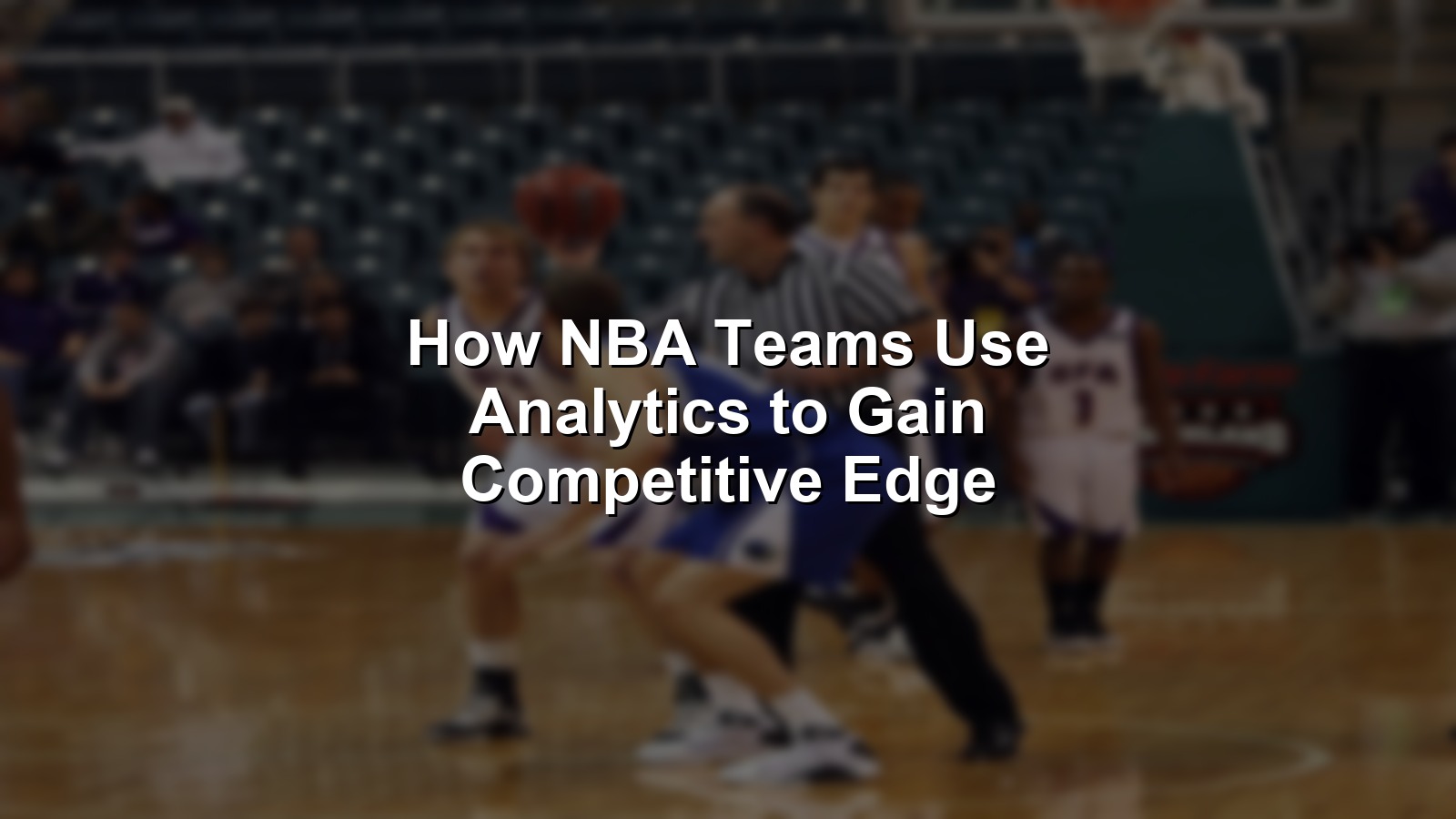
It was Game 6 of the 2014 NBA Finals—Miami facing San Antonio, Spurs leading by 20, with each possession killing another Heat hope. But buried in every Spurs run and Danny Green corner 3 lay a subtler storyline: how NBA teams use analytics is rewriting the blueprint for championship basketball, from the corners to the front office.
The rise of analytics isn’t just about numbers—or even about winning titles. It’s about longevity, innovation, and forcing the league’s brightest to adapt or fall behind. For every team keeping score on the court, another is recalibrating odds off it, searching for insights hidden in the data streams.
Analytics now shape the league’s tides, bending strategies, war rooms, and even fan debates. Unpacking these moments tells the story of why rings—and the way they’re won—are changing forever.
Context: Why This Matters
Walk into any barbershop, radio call-in, or Twitter thread, and you’ll get the same old debates: “Does more talent or more rings make you an all-timer?” “Was Jordan better than LeBron?” “Do stats really tell the truth?”
Analytics add a new wrinkle. They pull back the curtain, revealing the hidden value in role players, exposing weaknesses in legends, and shifting the terms of the fight. It’s no longer just about highlights, but about impact—measured, replayed, and sometimes weaponized.
Winning titles? Still the ultimate currency. But how teams get there has changed. When data became part of the championship equation, every game became a chess match—and every fan started watching differently.
Methodology
Ranking the biggest ways analytics have transformed NBA teams means weighing legends against innovators, moments against movements.
We considered:
- Direct playoff or Finals impact (about 40%)
- Longevity and sustained adoption across multiple teams/eras (30%)
- Influence on league strategy, team building, and player development (20%)
- Cultural and league-wide perception, including quotes or media consensus (10%)
Sources include official NBA stats, Basketball-Reference, long-term media features, and notable analytics leaders. We leaned on in-depth coverage from NBA.com and history arcs like the Hall of Fame’s Basketball Analytics timeline. Comparison across eras is unavoidable—and so are a few hard choices about what “impact” really means.
The Moments That Changed Everything
1. The Houston Rockets’ Three-Point Revolution
It’s 2018: Game 7 of the Western Conference Finals. The Rockets miss 27 straight threes—a streak that echoes louder than any stat. Yet, the mere fact that Houston is here, launching from distance at historic rates, is proof of analytics’ power.
By making three-point math their gospel, Daryl Morey’s Rockets reimagined shot selection. Their pace-and-space system multiplied wins and turned solid role players into valuable floor-spacers. Houston didn’t capture a ring in the Morey-Harden era, but the league would never shoot—or scout—a traditional big the same way again.
“We’re not afraid of the math,” Morey once explained. It was bold. It changed front offices coast-to-coast, and inspired a decade of copycats.
Key facts:
– Most three-point attempts per game in NBA history (2016–2021)
– Top playoff seed three times
– Redefined offensive spacing and player archetypes
Authoritative sources: nba.com/rockets, basketball-reference.com/teams/HOU
🧵 On X
https://x.com/search?q=Houston%20Rockets%203%20point%20revolution&src=typed_query
2. Spurs Ball Movement and Shot Charts
Flash back to the 2014 Finals. The Spurs didn’t just beat the Heat—they diced them up, racking up a record number of passes per play. Every corner three reflected their embrace of analytics-led spacing and “good-to-great” principles.
Gregg Popovich had always preached teamwork, but it was Director of Basketball Strategy Ben Alamar and a backroom staff who translated data into on-court actions. Their shot charts, targeting high-efficiency corners, set a template now standard across the league.
As Kawhi Leonard hoisted Finals MVP, even old-school skeptics took notice. The dynastic Spurs showed that you could use analytics for beautiful basketball—not just bean-counting.
Key facts:
– Record-high team assist percentages
– 5 NBA titles during Popovich era
– Emphasis on corner threes and floor geometry
Authoritative sources: nba.com/spurs, espn.com/nba/story/_/id/11078966
🧵 On X
https://x.com/search?q=Spurs%20ball%20movement%20analytics&src=typed_query
3. Golden State Warriors: Splash Brothers and Shot Selection
May 2016. Klay Thompson sinks his 11th three in Game 6, lifting the Warriors over the Thunder. Steph Curry grins: their long-range barrage, built on analytics and confidence, has changed what’s “possible” from the perimeter.
Golden State’s success is more than just shooting. It’s “shot value” dictionaries for every rookie and a coaching staff that demands efficiency. The movement-heavy, “gravity” offense—quantified and tracked by the team’s data scientists—forces opponents to rethink defense itself.
No team turned the math into banners more convincingly than the Warriors.
Key facts:
– 4 NBA titles in 8 years (2015–2022)
– Curry: all-time leader in 3PT made
– Revolutionized off-ball movement analytics
Authoritative sources: nba.com/warriors, basketball-reference.com/teams/GSW
🧵 On X
https://x.com/search?q=Warriors%20analytics%20offense&src=typed_query
4. Defensive Matchup Data: The Toronto Raptors and 2019 Finals
2019 NBA Finals. Kawhi Leonard leads the Raptors over the Warriors. The most iconic image? Toronto’s defense packing the paint, stunting on Curry, exploiting every detail of matchup metrics honed by their analytics department.
The Raptors—fueled by stats from Alex McKechnie’s staff—used real-time player tracking and “matchup win probabilities” to dictate their lineups and rotations. Their staff visualized the Warriors’ hot zones and built a wall for Giannis in the ECF, again guided by the numbers.
As Nick Nurse said: “You have to use every tool to win.” Toronto did, and earned the ultimate reward.
Key facts:
– 2019 NBA champions (first in franchise history)
– Emphasis on player tracking and opponent shot profiles
– Landmark use of video and data merges on opponent stars
Authoritative sources: nba.com/raptors, espn.com/nba/story/_/id/26965313
🧵 On X
https://x.com/search?q=Raptors%202019%20finals%20analytics&src=typed_query
5. The Rise of Player Tracking and SportVU Cameras
Picture the 2013–14 season: Suddenly, every NBA arena is filled with blinking, ceiling-mounted cameras. SportVU is here—capturing every dribble, pass, and movement in a metric never seen before.
Teams went from box scores to billions of new data points: speed, distance, “hockey assists,” defensive contests. Coaches got granular with matchups; trainers altered conditioning; agents pointed to movement stats in contract talks.
SportVU (and now Second Spectrum) is the “great leap forward” in how NBA teams use analytics—fueling smarter scouting, drafting, and even game time-outs.
Key facts:
– Full league-wide adoption in 2013–14
– Hundreds of new advanced stats (touches, catch-and-shoot %, etc.)
– Massive behind-the-scenes impact on scouting and player health
Authoritative sources: nba.com/stats, nba.com/news/2013-10-15-nba-sportvu-cameras
🧵 On X
https://x.com/search?q=NBA%20SportVU%20analytics&src=typed_query
6. Moneyball Mentality: The Morey Tree Branches Out
Every draft night brings a familiar sight: execs huddled with spreadsheets, not just tape. Daryl Morey’s influence spread from Houston to Philadelphia and beyond, as his disciples—Sam Hinkie and beyond—used analytics to value shooting, pace, and draft upside.
This “Moneyball mentality” recalibrated how teams value picks, injuries, and risk. Sometimes, like Philly’s “Process,” it meant short-term pain for long-term odds. Not every fan loved it.
As one Sixers fan quipped: “Trust is hard, but losing is worse.”
Key facts:
– Multiple playoff and Finals appearances across franchises
– First “Process” to tank with goal of maximizing pick value (2014–2016 Sixers)
– Dozens of teams now embed stats experts in top decision roles
Authoritative sources: nba.com/sixers, basketball-reference.com/executives/moreyda01.html
🧵 On X
https://x.com/search?q=NBA%20Moneyball%20analytics&src=typed_query
7. Defensive Analytics: Utah Jazz and Rudy Gobert
Game 7, first round, 2020 NBA bubble. Rudy Gobert anchors the paint, arms outstretched, forcing yet another Denver miss—his presence measured not just in blocks, but shot-alteration data and DFG% (defended field goal percentage).
Utah built their team around the numbers: prioritizing rim protection, funneling drivers into Gobert, and relying on “expected shot value” rather than old scoring averages. The Jazz modeled their entire defensive system on what the data spelled out.
Gobert became a perennial DPOY candidate—and modern NBA defense became defined by more than highlight swats.
Key facts:
– 3x NBA Defensive Player of the Year (2018, 2019, 2021)
– Utah: league-best defensive efficiency (multiple seasons)
– DFG % and rim deterrence now core to team-building
Authoritative sources: nba.com/jazz, basketball-reference.com/players/g/goberru01.html
🧵 On X
https://x.com/search?q=Gobert%20defensive%20analytics&src=typed_query
8. Load Management: Kawhi Leonard and the New Science
April 2021. Kawhi Leonard sits again—healthy, but resting. The Clippers’ medical staff have crunched his injury probabilities and decided he’ll skip tonight, hoping he’s fresher in June.
Load management isn’t just about rest days: it’s fueled by analytics from wearable tech, player tracking, and long-term durability studies. Teams now design schedules with data on injury risk and efficiency curves—sometimes clashing with league policies and fan expectations.
It’s controversial, but as one old NBA trainer notes, “You can’t win if you can’t walk.” The numbers, for better or worse, agree.
Key facts:
– Clippers and Raptors led NBA in “load management games”
– Data-driven approach to player health
– Spurred league-wide copycat policies and debates
Authoritative sources: nba.com/clippers, espn.com/nba/story/_/id/27214659
🧵 On X
https://x.com/search?q=Kawhi%20load%20management%20analytics&src=typed_query
9. Draft Analytics: Finding the Hidden Gems
2013 NBA Draft. Most analysts sleep on Giannis Antetokounmpo, but Milwaukee’s analytics staff—armed with advanced international film and projections—see potential high above his pick slot.
In the past decade, advanced draft models, “PER projections,” and bio-metric data have allowed several small- and mid-market teams to land future stars deep in the draft. It’s not perfect, but it’s helped widen the pool of prospects teams trust.
“This is where the game is won—in the margins,” says one scout. Analytics just helped widen those margins.
Key facts:
– Giannis: 2-time MVP, picked #15
– Dozens of All-Stars drafted outside lottery with analytics help
– Models now guide G League and overseas prospect picks
Authoritative sources: nba.com/bucks, basketball-reference.com/draft/NBA_2013.html
🧵 On X
https://x.com/search?q=NBA%20draft%20analytics&src=typed_query
10. In-Game Adjustments: Real-Time Analytics Staff Courtside
There’s a timeout at the 2023 playoffs. An assistant races to the head coach, iPad in hand—a play chart showing which pick-and-roll combos are giving up the most points this quarter.
This scene is everywhere now: analytics staff courtside, sending live numbers to coaches making real-time adjustments. Whether by tablet or headset, NBA benches now react not just to eye-test but to possession-by-possession shot quality and progress charts.
It’s the “Moneyball” moment for rotations, and it’s still evolving.
Key facts:
– Every NBA team employs data staff during games
– In-game player and lineup efficiency stats widely used
– Influences substitutions, play calls, and even reviews
Authoritative sources: nba.com/news/nba-benches-analytics, espn.com/nba/story/_/id/34741915
🧵 On X
https://x.com/search?q=NBA%20in-game%20analytics&src=typed_query
Final Thoughts
If you want to understand how NBA teams use analytics, start with these ten shifts. Together, they show that impact isn’t about one player, stat, or even one ring—it’s about changing what’s possible.
Championships still matter. But the next dynasty may very well have their biggest star in a backroom, decoding matchups, movements, and moments invisible to the naked eye.
As team decision-makers get younger, and as technology evolves, expect new metrics—fatigue, mindset, chemistry—to start changing the game anew. The league’s future is as much about data as dunks.
Tomorrow’s “best ever” debates? They’ll blend highlights and spreadsheets. Welcome to the new normal.



